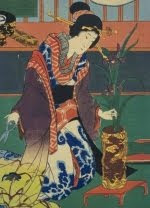One of the main settings for Japanese flower arranging is the Tea Ceremony. I have discussed the relation between ikebana and chabana (tea flowers) in an earlier blog post. To me it looks like the tea practitioners are more likely to focus on the differences than ikebana practitioners are. These two quotations from Wikipedia gives a nuanced tea ceremony perspective on chabana:
Although it is true that the ideal is simplicity and a less formal style, there are probably even more rules for chabana than there are for other Japanese flower arranging. This is because chabana is always integrated in the tea ceremony and follows the rules and grades of formality that are so essential to this tradition.
Chabana evolved from the "free-form" style of ikebana called nageire (投げ入れ?), literally "throw (it) in", which was used by early tea masters. Chabana is said, depending upon the source, to have been either developed or championed by Sen no Rikyū. He is said to have taught that chabana should give the viewer the same impression that those flowers naturally would give if they were [still] growing outdoors, in nature.
(Wikipedia search: Japanese tea ceremony March 6, 2012)
A less formal style of Ikebana arrangement was added to the more stylized rikka arrangement and was called nageire, or thrown in style. This new style had fewer rules and appealed to those who were searching for a more simple and natural look. Early tea masters used the nageire style until it further divided into the seika, pure chabana, tea flower, styles. The chabana style, with no formal written rules, became the standard style of arrangement for Chanoyu.
(Wikipedia search: Chabana March 6, 2012)
 |
| Photo: www.enshuryu.com |
The beauty of simplicity always strikes me when i see a good chabana arrangement. I came across the website of the Enshu Sado School of tea, and their picture gallery with "flowers for a tea occasion". Have a look if you like tea flowers. The pictures are beautiful and there are also comments on what flowers to use. The Japanese site is more recently updated than the English translation so that will be the best place to look. I used google translator for the comments and that worked fine.












No comments:
Post a Comment